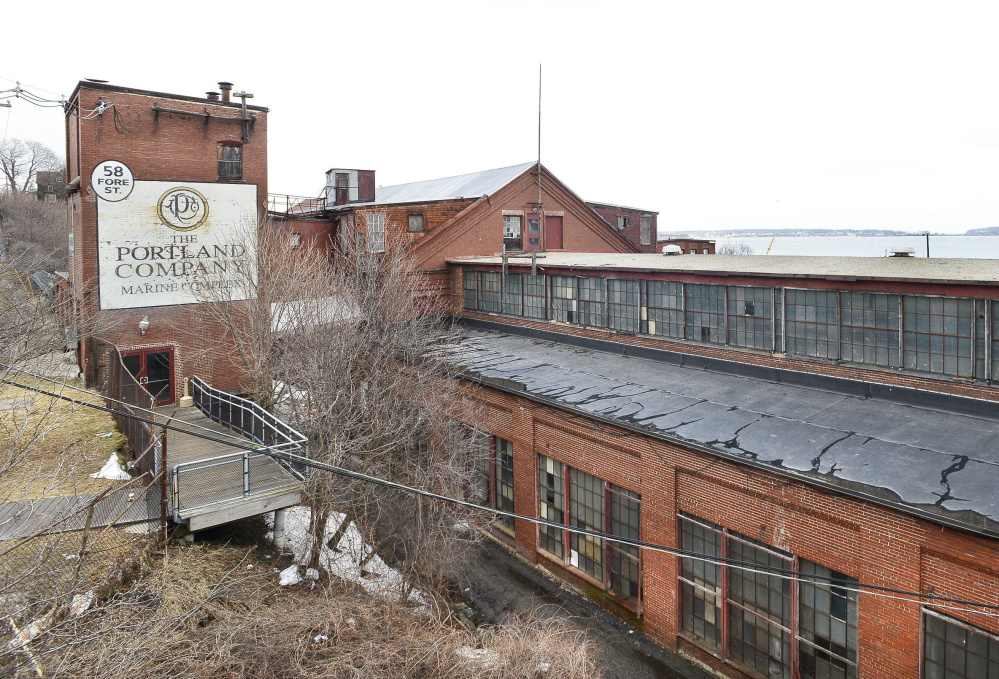Portland city councilors have another difficult decision to make about the redevelopment of the former Portland Co. complex on the city’s eastern waterfront: Preserve a prominent historic building or allow it to be torn down so the public can have guaranteed access and sight lines to the waterfront through the property.
Preservationists want the former machine erecting shop to be saved and repaired while the city’s Planning Board and development community support removing the building as part of the high-profile redevelopment project at 58 Fore St.
The council will hold a public hearing Wednesday at 5 p.m. at City Hall ahead of a scheduled vote.
Mayor Ethan Strimling said he would like to see the building preserved, but wants to hear from the public before casting his vote. “My bar for tearing down a historic structure is pretty high,” Strimling said.
The Historic Preservation Board has proposed a historic district that covers 4.3 acres of the roughly 10 acre site, and lists eight of 16 buildings – including the old erecting shop – as contributing structures, meaning they would need to be preserved.
The Planning Board, however, amended that recommendation to remove the former erecting shop, which is also referred to as Building 1, and reduced the size of the proposed district, excluding land to the west of the entry road.
The initial preservation board review examined the building’s historical significance and physical condition, while the Planning Board considered other objectives laid out in the city’s comprehensive plan covering land use.
The developer, CPB2, supports the Planning Board recommendation. CPB2 is offering the city a 50-foot wide right of way, giving the public access from Fore Street to the waterfront, in exchange for being allowed to tear down the building, which has been deemed salvageable, but extensive structural work would be needed.
CPB2 principal Jim Brady said preserving the erecting shop would have “profound” effect on the redevelopment. He argues that the building behind the erecting shop – a Greek Revival style structure built in 1847 as the Portland Co.’s original machine shop – is more valuable.
“Building 2 (the machine shop) is the most historically and architecturally significant building of the former Portland Co.,” Brady said in an email Tuesday.
Founded in 1846, the Portland Co. complex was built to support an effort to connect Portland to Montreal by rail and it was the first locomotive factory in the U.S. that brought all of the necessary shops and foundry together on one site. It remained in operation for 137 years and was deemed eligible for the National Register of Historic Places in 1976.
City Councilor Belinda Ray, who represents the East End, said she has received many emails about the upcoming vote and opinions appeared to be split.
She plans to offer an amendment that would protect Building 1, while following the Planning Board’s recommendation for changing district boundaries to remove part of the site.
“This is a really tough vote,” Ray said. “It’s an issue people all over Portland are weighing in on.”
Greater Portland Landmarks, which was formed after the demolition of Union Station, had supported the Historic Preservation Board’s recommendation.
Landmarks Executive Director Hilary Bassett said Tuesday that the group would support Ray’s amendment, because the group is primarily focused on saving Building 1 to convey the site’s former use as a locomotive assembly line.
Bassett said the erecting shop, which is used for the popular flower and boat shows, is what the public considers to be the Portland Co.
“We are optimistic the councilors will see the value in preserving Building 1,” Bassett said. “Once a building is demolished, it’s gone for ever. It’s better to err on the side of preserving a building rather than regretting you tore it down years later.”
However, the Portland Society for Architecture, a nonprofit group formed in 2006 to encourage progressive development policies, supports the Planning Board’s recommendation.
The group agrees with the developer that the building masked by the former erecting shop has more value.
“We can also state that the mid-19th century building now obscured by Building 1 is of greater architectural merit,” the society said in a Feb. 16 email to supporters. “The district as currently proposed to you will showcase better architecture and create more design opportunities for public views and access to the waterfront.”
The last time the City Council took up a proposal for the Portland Co. – a vote to rezone the site to allow for taller buildings and a wider range of uses, including hotel, residential and restaurants – the move was challenged unsuccessfully in a citywide referendum.
Send questions/comments to the editors.



